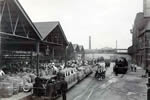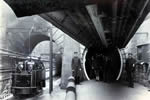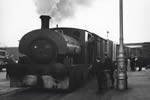The St. James's Gate Brewery Railway and Locomotives

This divided the Brewery in two creating an 'upper' level and a 'lower' level separated by James's Street. Several departments were moved to the new 'lower level' including the Cooperage, washing and filling sheds. However, it became more and more difficult to move materials around the much larger site with horse-power alone. The Company's solution was to construct a railway. The Brewery's newly appointed Engineer-in-Chief, Samuel Geoghegan, oversaw its construction.
In designing the railway, two difficulties had to be overcome. Firstly, the track needed to be narrow enough to navigate through the Brewery, but a connection was still needed to the broad gauge track in Kingsbridge. The solution was to lay two different types of track - a 22” narrow gauge system for working within the Brewery boundaries, and a 5ft 3in broad gauge system to link to Kingsbridge. A broad gauge tramway connection along St. John's Road was authorised to Great Southern & Western Railway by an Act of Parliament in 1874 to serve the Brewery from Kingsbridge station.
Secondly, there was the problem of how to link the track between the 'upper' and 'lower' levels - with a difference in height between them of 50 feet. This was initially overcome by using a hydraulic lift to lower the locomotives down to the lower level - this eventually proved too slow. In 1875, Samuel Geoghegan proposed that a tunnel be built to bring the locomotives from the upper to the lower level. A spiral rather than a straight tunnel was built, to cope with the difference in height. The tunnel, similar in design to tunnels through the Alps, turned 2.5 revolutions under St. James's Street. The spiral tunnel had a radius of 61ft 3” and cost £3000. Locomotives were then used to haul malt-wagons, spent grains, casks, and even hops around the Brewery from one level to the other.
By the time the railway was complete in 1877, there was two miles of track within the Brewery site.
 The narrow gauge engines, which ran along the railway within the Brewery site, were initially all steam-powered.
The narrow gauge engines, which ran along the railway within the Brewery site, were initially all steam-powered.
The first five narrow gauge locomotives were bought between 1875 and 1878. The two bought in 1876, No.2 and No.3, were known as 'Malt' and 'Hops', and weighed 5 tons each. None of these engines proved entirely satisfactory and so Samuel Geoghegan set about designing an engine himself. Geoghegan's new design provided dirt protection – the absence of this on the previous five had caused a lot of problems. The first Geoghegan engine, the 'No. 6', was built by Avonside Engine Company in 1882. The design proved so successful that another seventeen were manufactured between 1887 and 1921, all built locally by William Spence at the Cork Street Foundry. These engines survived right through the second world war and were only withdrawn gradually as the new 'Planet' diesel engines were introduced; numbers 23 and 24 lasted until 1957.

The narrow gauge railway was in use right up until 1975. Today Geoghegan engine No. 17 and a Planet diesel engine No. 47, both feature in the Transport display at GUINNESS® STOREHOUSE. No. 13 Geoghegan engine is preserved at the Narrow Guage Railway Museum in Wales.
The broad gauge railway connected the Brewery to Kingsbridge station, running out of the Brewery along the public highway to the Station's goods yards (a distance of about 500 yards). Instead of buying new broad gauge locomotives, Samuel Geoghegan designed special 'haulage wagons' to allow existing narrow gauge locomotives to drive on the broad gauge. The narrow gauge locomotives were hoisted onto the wagons, which would then transmit the drive from the narrow gauge wheels of 1ft 10in to the broad gauge wheels of 5ft 3in.
 Eventually, broad gauge locomotives had to be purchased. The No. 1 broad gauge engine, built in 1912 by Straker & Squire Ltd of London, was a four wheeled petrol locomotive and lasted until 1916. The No.2, introduced in 1914, and the No.3, introduced in 1919, were both 0-4-0 saddle tanks, built by Hudswell Clarke. As these engines used the public tramway, they were provided with 'skirts', all round, to enclose their wheels, and were fitted with a brass bell.
Eventually, broad gauge locomotives had to be purchased. The No. 1 broad gauge engine, built in 1912 by Straker & Squire Ltd of London, was a four wheeled petrol locomotive and lasted until 1916. The No.2, introduced in 1914, and the No.3, introduced in 1919, were both 0-4-0 saddle tanks, built by Hudswell Clarke. As these engines used the public tramway, they were provided with 'skirts', all round, to enclose their wheels, and were fitted with a brass bell.
An increase in road traffic lead to the demise of the broad gauge as St. John's Rd (separating the Brewery from Kingsbridge) was needed for motor traffic. By the end of 1965, No. 2 was scrapped, and No. 3 was presented to the Irish Preservation Society.